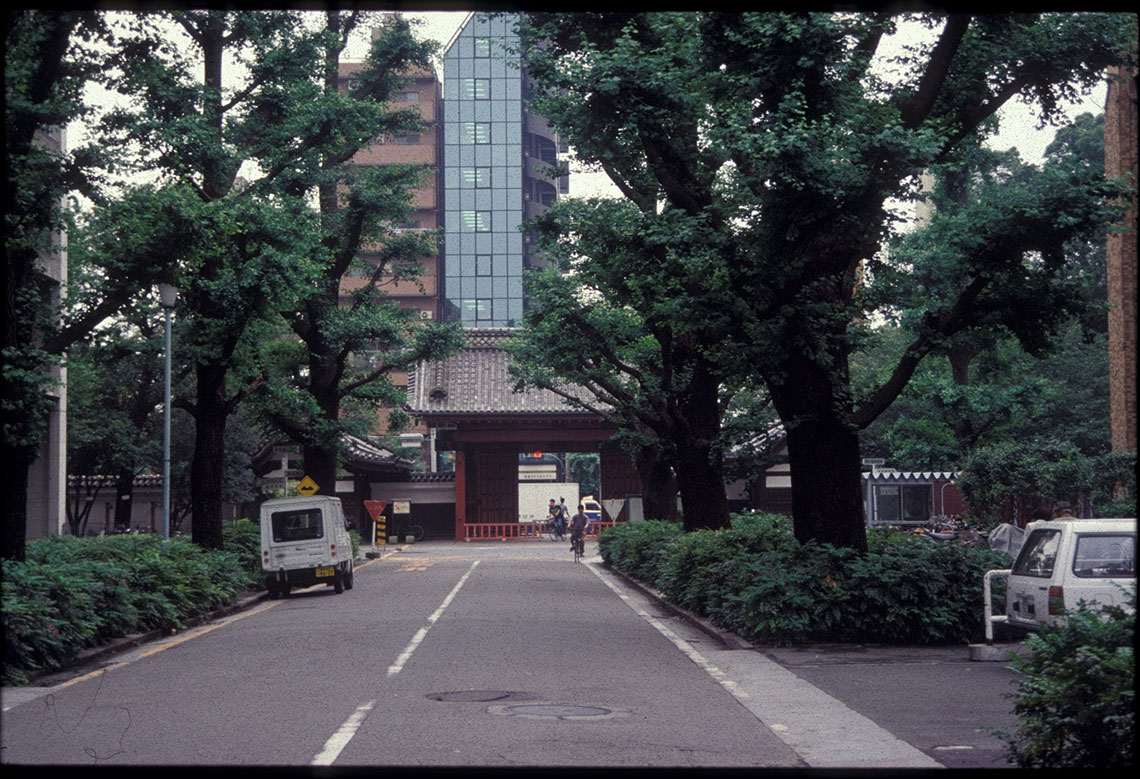It is but a short distance to Kanda, so the traveler may well take a detour through the university grounds, entering through the main gate. It is historic in many ways, having been the Edo residence of the Maeda, daimyo of Kaga, as well as the scene of some of the worst student confrontations in the late 1960s. The Maeda held one of the richest domains with a nominal tax yield of over one million koku (one koku is about 5 bushels) and probably considerably more. They could well afford to paint a gate red to celebrate a daughter marrying a shogun.

The university grounds are now a combination of ultramodern and old buildings. The old ones are covered with medium sized tiles which were always falling off until a major renovation project in the early 1980s. In the center is Yasuda Auditorium which the students occupied in 1968-9 and were only dislodged after helicopters “softened” them up by dropping tons of water before the riot police moved in. It took 8,500 police two days to get the fire-bomb throwing students out of the auditorium. Yasuda is now a center for student services rather that the hated administration’s headquarters. Beyond Yasuda and behind the university is a small shrine, Nezu Jinja, which is famous for its festival in May dedicated to the azalea with which it is heavily planted. The Nezu was full of dormitories for university students in the 1870s and 1880s. It was also a brothel district until the government cut the two groups asunder in 1888, moving the brothels further east.
Turning right past the main library (which still uses prewar-vintage tokens marked “Tokyo Imperial University” when books are loaned) and right again, one comes out of the university through Akamon (the “Red Gate”) which the Maeda lacquered red in their daughter’s honor. Across the street is a shop selling Akamon mochi, a red sweet made of glutinous rice. Almost directly behind the shop, but a block away, is the site of the Kikufuji Hotel where many literary and cultural figures stayed earlier this century. Osugi Sakae and Ito Noe, anarchists who were murdered by military police after the 1923 earthquake, stayed at the hotel. Osugi was then trying to work out a systematized scheme by which men and women could maintain separate residences and many lovers, but one of his lovers stabbed him so he divorced his wife and settled down with Ito, his second lover at the time.

Turning left, one jostles with the masses of students coming toward the university. On the west side of the street are a number of bookstores, art galleries and coffee shops; on the east are mainly medical supply wholesalers with odd implements and organs in formaldehyde in the display windows. After passing the Hongo Sanchome subway station, the pedestrian traffic thins out. The highway passes quietly behind a large medical hospital which overlooks Ochanomizu station, an extremely busy station serving only, it seems, students. South of the station are private universities and bookstores by the dozen. Kanda Shrine, which stages one of the largest festivals eulogizing the Edo period, appears on the left and suddenly the highway turns sharply into Kanda district.

Kanda Shrine
Kanda is written with characters meaning “Field of the Gods” but it is impossible to find any open fields now. In the Edo period, however, the Kanda Shrine and other temples and shrines were lined up along the divide between districts reserved mainly for samurai and districts reserved mainly for commoners. These temples were moved here, and the pine trees were planted along the Kanda River to the right, after one of Edo’s many fires swept through in 1657. The authorities insisted on temples and trees as a firebreak between the commoners’ districts and the castle.


